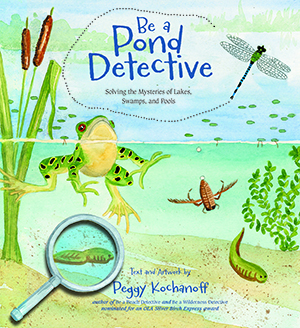| ________________
CM . . .
. Volume XXIII Number 4. . . .September 30, 2016
excerpt:
Nature study kindles many questions among young readers, and those who have the opportunity to spend time around wetlands will have a long list. Be a Pond Detective offers a brief introduction to a dozen common pond creatures and plants using a Q/A format to lead into a general description for each example. Details are well supported with clear watercolour illustrations. Readers are invited to “Look, listen, smell and touch!”, and there are adequate instances for those sensory activities. The author has included excellent comparison charts for frogs/toads, and dragonflies/damselflies. Since most of the animals and plants are found across North America, the book will be attractive to a wide audience. However, the painted turtle is described as “common in Atlantic Canada” without also acknowledging its presence across the continent. Only one example—the eastern newt—is limited in its range to eastern regions. Several of the species will be familiar enough to most youngsters: frogs/toads, mosquitoes, red-winged blackbirds that there may not be as much new information on those pages as can be found in the investigation of others such as dragonflies/damselflies, muskrats, cattails, duckweed, pond insects and leeches. The eastern newt opening question (“Why does the eastern newt eventually turn green?”) may be puzzling to youngsters (especially outside Atlantic Canada) who haven’t encountered this creature or who had no idea it changed colour. Rather, they might first wonder if the red eft and green newt (the two forms they are most likely to spot at a pond) is indeed the same animal. A more precise question needed? Another clarification issue: the discussion of duckweed includes a statement about oxygen dissolving in cool water, but no way to connect that detail to the previous information about duckweed controlling algae growth. Kids will need some explanation to understand this point. A puzzle page showing all the creatures in a pond setting with the invitation to identify them is a fun way to reinforce learning. But it might be more challenging if the solution was overleaf, rather than clearly visible beside the puzzle. A glossary is added, a good idea as there are quite a few scientific terms, and not all are defined in context. Some carelessness is evident, though, in the definitions: “genes” do more than control “the appearance of a living thing”, and the verb ‘secrete’ is defined as “a substance given off from a cell or gland.” Aside from these matters, overall Be a Pond Detective is a useful introduction to pond species that many youngsters may run across in the outdoors. The author’s note to “cherish and respect the environment” is worthy advice at this early learning stage. With this handy book as a starting point, kids can dig into other resources to satisfy their curiosity further. Recommended. Gillian Richardson is a freelance writer living in BC.
To comment on this title or this review, send mail to cm@umanitoba.ca.
Copyright © the Manitoba Library Association. Reproduction for personal use is permitted only if this copyright notice is maintained. Any
other reproduction is prohibited without permission.
CM Home |
Next Review |
Table of Contents for This Issue - September 30, 2016
| Back Issues | Search | CM Archive
| Profiles Archive |
